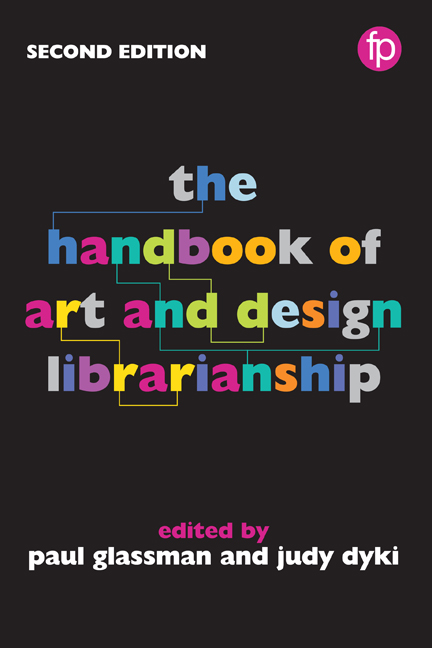Book contents
- Frontmatter
- Contents
- List of figures and tables
- Notes on contributors
- Foreword
- Preface
- Part I Roles and responsibilities
- 1 The governance and administration of the art and design library
- 2 Evolution not revolution: evolving trends in art and design libraries
- 3 Expanding roles for fine arts liaison librarians: re-visioning the liaison model
- 4 Accreditation and visual arts libraries
- 5 Design thinking for design librarians: rethinking art and design librarianship
- Part II Materials and collection management
- Part III Teaching and learning
- Part IV Knowledge creation
- Part V The physical environment
- Part VI Promotion and sustainability
- Appendix Library profiles
- Index
2 - Evolution not revolution: evolving trends in art and design libraries
from Part I - Roles and responsibilities
Published online by Cambridge University Press: 08 June 2018
- Frontmatter
- Contents
- List of figures and tables
- Notes on contributors
- Foreword
- Preface
- Part I Roles and responsibilities
- 1 The governance and administration of the art and design library
- 2 Evolution not revolution: evolving trends in art and design libraries
- 3 Expanding roles for fine arts liaison librarians: re-visioning the liaison model
- 4 Accreditation and visual arts libraries
- 5 Design thinking for design librarians: rethinking art and design librarianship
- Part II Materials and collection management
- Part III Teaching and learning
- Part IV Knowledge creation
- Part V The physical environment
- Part VI Promotion and sustainability
- Appendix Library profiles
- Index
Summary
Introduction
Art and design libraries do not look like or position themselves the way they did in the past. Team rooms, maker spaces and galleries have been added. Arts collections are hybrid but rarely all digital. Resources such as material samples are being collected. Staff job titles and duties have shifted. Libraries are different, but much of what is being done currently or is being considered builds on the past. Libraries evolve, responding to internal challenges and outside forces.
This chapter explores some recent library trends and their effect on art and design libraries in particular. It uses a survey distributed in October 2016 by the author to relevant listservs, a literature search and over 40 years of work experience to identify evolving trends in buildings, staffing and collections and to define how and why they are occurring. The author sent the 16-question survey covering many aspects of arts librarianship to ARLIS-L (Art Libraries Society of North America), ARLIS-LINK (ARLIS/UK & Ireland: the Art Libraries Society), AASL-L (Association of Architecture School Librarians), and ACRL/ARTS (Arts Section of the Association of College and Research Libraries). The full survey and the responses may be viewed on Facet Publishing's website (bit.ly/OparSurvey).
Services
Circulation
‘Public service’ was the old umbrella term for activities related to assisting the public. Reference, circulation and instruction were considered essential, and staffing was structured accordingly. These services remain central to the library's mission, but administratively they may reside in different departments. Circulation desks are still present, but self-service options have been added. At the Architecture Library of the University of Maryland, for example, self-checkout is the norm (Frank, 2016). In some libraries, circulation and reference are handled at the same desk, with staff from different units working side by side.
Non-circulating libraries do exist, but the trend is to circulate most materials and increase access. Pragmatic libraries may see circulation as a quick way to secure shelf space. Art and design libraries must consider circulation policies for challenging formats, such as pop-up books or portfolios with loose plates. Some libraries choose to restrict circulation of these formats.
- Type
- Chapter
- Information
- The Handbook of Art and Design Librarianship , pp. 15 - 24Publisher: FacetPrint publication year: 2017
- 1
- Cited by



